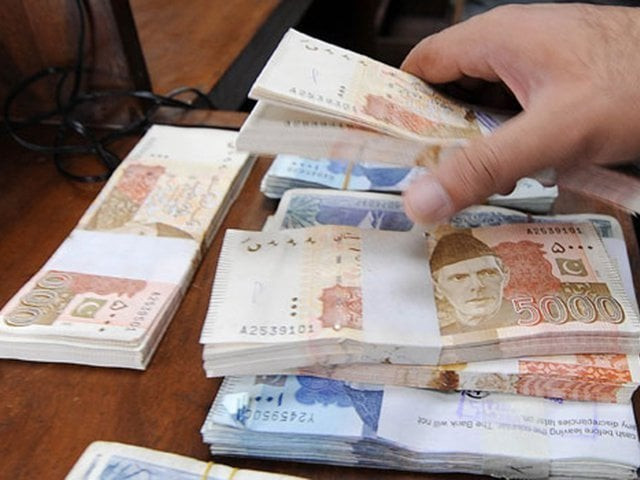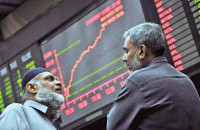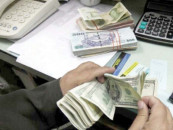Pakistan govt’s debt swells to Rs23.6tr to bridge budget gap
Increases 13.7% in Jul-Apr as govt does not utilise its deposits kept with banks

The finance ministry reported a Rs1.481-trillion budget deficit for nine months of FY18, which was equal to 4.3% of gross domestic product (GDP).
PHOTO: EXPRESS
The State Bank of Pakistan’s (SBP) latest central government debt bulletin for the period July-April showed that the finance ministry accumulated far more-than-required debt. The federal government is not utilising its deposits that are placed with banks and is instead acquiring more debt to meet its expenses.
The data showed that the federal government’s debt ballooned to Rs23.6 trillion by the end of April this year. There was a net increase of Rs2.838 trillion, or 13.7%, in first 10 months of the current fiscal year compared to the level in June 2017.
The finance ministry reported a Rs1.481-trillion budget deficit for nine months of FY18, which was equal to 4.3% of gross domestic product (GDP). However, the net addition of Rs2.838 trillion to the government debt in 10 months was equal to 8.3% of GDP. The growing debt burden has triggered a national debate on sustainability of the country’s macroeconomic framework.
Other reasons for the increase in debt were rupee depreciation and placement of government deposits with commercial banks, which was a flawed policy and aimed at fattening the banks.
Profit rates on these deposits that the federal government received were far lower than the cost it paid on acquiring the debt, said sources in the finance ministry.
The SBP has already highlighted the issue in its first half report on the state of economy.
The federal government’s total domestic debt increased to roughly Rs16.2 trillion, an addition of Rs1.4 trillion or 9.2% in 10 months. The domestic debt structure underwent a drastic change, which exposed the finance ministry to refinancing risks.
The share of short-term public debt increased alarmingly to 54.4% or Rs8.82 trillion by the end of April. In June last year, the short-term domestic debt stood at 44% or Rs6.6 trillion. The short-term debt grew Rs2.27 trillion or 34.7% in 10 months. The rise in the short-term debt was the result of growing dependence on borrowing through sale of market treasury bills (MTBs).
Pakistan uses Chinese trade finance to repay foreign debt
The federal government’s total borrowing through MTBs increased to almost Rs5.2 trillion, up 25.7% or Rs1.05 trillion in 10 months. Similarly, the MTBs issued to replenish cash rose to Rs3.7 trillion, a net addition of Rs1.221 trillion from July through April.
Another reason was that the federal government started relying on the central bank for financing its deficit, which changed the debt structure. The change in the composition of domestic debt suggests that the government could not fully implement its second Medium-Term Debt Management Strategy 2016-19 that had been designed to increase the maturity profile to reduce the refinancing risk.
In contrast to the short-term debt, the country’s long-term debt decreased 11% to Rs7.4 trillion. Its share was 56% in the total domestic debt at the end of June 2017, which fell to 45.5% by April this year.
Pakistan’s external debt grows at fastest pace in four years
The share of bonds issued by the federal government shrank from Rs4.8 trillion to Rs3.74 trillion despite an overall increase in public debt. A net reduction of Rs1.03 trillion or 21.6% in bond holdings indicates that banks are not willing to lock funds for longer periods despite getting favours from the federal government.
However, the debt acquired through the sale of prize bonds increased from Rs747 billion to Rs826 billion at the end of April 2018.
The external debt jumped by one-fourth to Rs7.4 trillion in the first 10 months of the current fiscal year. There was a net increase of Rs1.5 trillion in the external debt and a major reason was the depreciation of rupee against the US dollar.
Pakistan’s external debt, liabilities touch $89 billion
These figures do not include the debt of Rs691 billion taken from the International Monetary Fund, which is the responsibility of the central bank.
Published in The Express Tribune, June 12th, 2018.
Like Business on Facebook, follow @TribuneBiz on Twitter to stay informed and join in the conversation.



















COMMENTS
Comments are moderated and generally will be posted if they are on-topic and not abusive.
For more information, please see our Comments FAQ